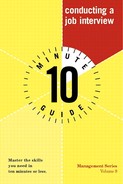In his biography, Lee Iacocca said, "I learned to figure people out pretty quickly. That's an important skill to have, because the most important thing any manager can do is hire the right new people."
If you're a manager charged with the responsibility of hiring new people for your organization, you need to recognize two things immediately: First, it is critical to the future of your organization that you hire only top-quality people who can hit the ground running and quickly contribute to the success of your enterprise. Second, the traditional hiring methods used by business and industry over the past 50 years don't work—you need to find better ways of separating potentially successful job candidates from also-rans.
The future of your organization is literally in your hands. Every time you hire a new employee you change the character and potential of your organization for better or worse. A uniquely wonderful opportunity belongs to those who conduct job interviews.
But there's also a downside. Hiring mistakes can be costly. Not only does this involve the direct cost of salary and benefits paid to an employee who fails, but it also includes the cost of filling and refilling the position. Some studies have shown that direct costs attributable to a hiring mistake can easily equal four times the annual salary allocated for the position—and that number increases appreciably if the mistake is not rectified within the first six months of employment.
Indirect costs can also be staggering. Lost productivity, damage to customer relations, drain on management, and the harm to employee morale also represent significant cost and can have long-term impact on the organization.
It's sad, but true, that in spite of the costs involved, most businesses today spend more time buying a new copy machine than they do choosing the right employee. The results are predictably disastrous.
In this age of corporate downsizing, when more is expected of a shrinking number of employees, the skill of identifying potentially successful candidates for employment is becoming an essential management skill. Hiring mistakes must be minimized by better-quality interviews that spot potential problems before financial commitments are made.
It's a fact: Exceptional managers are exceptional interviewers. They hire successful candidates who produce more, do more to help the organization outperform the competition, promote higher levels of employee morale, and overall make a significant contribution to bottom-line profitability.
And here's some good news: Becoming an exceptional interviewer isn't that difficult. Any manager who is willing to lay aside old interviewing habits and techniques, and replace them with the behaviorally based interviewing skills taught in this book, will soon become a truly exceptional interviewer.
Equipping busy managers to plan, conduct, and evaluate exceptional interviews is what this book is all about. My aim is to give managers the tools they need to evaluate job applicants and reveal real strengths and weaknesses that will directly impact that individual's ability to succeed on the job.
Scattered throughout the 10 Minute Guide to Conducting a Job Interview are three icon boxes that contain useful and interesting additional information:
Tip
Tip boxes contain valuable suggestions to get you thinking.
Plain English
Plain English boxes define terms that might be new to you.
Caution
Caution boxes advise you of potentially tricky or dangerous pitfalls.
William W. Larson is a former Lutheran clergyman who holds a doctorate in management. He has served as the executive director and chief operating officer of Simon Greenleaf School of Law, and the executive director of the World Confessional Lutheran Association. He also is the founder and president of Selection Dynamics Institute of Tacoma, Washington, offering personalized training to supervisors and managers who make critical hiring decisions for their companies.
I wish to thank everyone at Macmillan USA who helped make this book possible. I am particularly grateful to Publisher Marie Butler-Knight; Mike Sanders, Acquisitions Editor; Mike Thomas, Development Editor; Krista Hansing, Copy Editor; Billy Fields, Production Editor; and all those involved in the printing, sales, and distribution of this book. The Macmillan team has been professional, motivating, and simply wonderful to work with. Special thanks also to Mike Magno of Clover Park Technical College in Lakewood, Washington for acting as technical editor for this book.
All terms mentioned in this book that are known to be or are suspected of being trademarks or service marks have been appropriately capitalized. Pearson Education, Inc., cannot attest to the accuracy of this information. Use of a term in this book should not be regarded as affecting the validity of any trademark or service mark.
